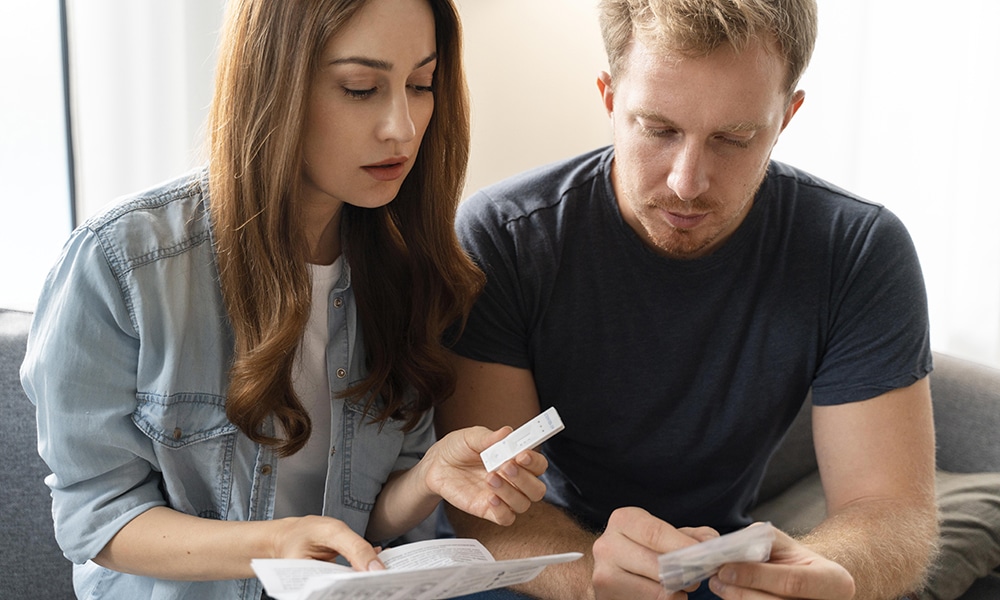A Comprehensive Guide to Safe Dating in the Age of Online Platforms
In today’s digital era, finding love or making connections through online dating platforms and apps

Getting tested for sexually transmitted diseases (STDs) may only seem necessary when you experience lasting symptoms, but many sexually active individuals only notice intermittent symptoms or none at all. Be sure to remain proactive about your sexual health by getting tested regularly, especially if you have many sexual partners, a new partner, or unprotected sex.
Understandably, you may be anxious or frustrated if you think you need STD testing, but you can take certain steps to prepare for STD test appointments to make the process as hassle-free as possible.
Anyone experiencing what may be STD symptoms should seek testing to prevent future health complications and avoid passing on the infection. Speak with your healthcare provider or schedule testing with us at Rapid STD Testing if you notice any of the following symptoms:
You may not need testing if you and your partner have both been tested during a monogamous long-term relationship. Healthcare professionals recommend testing for:
Your doctor can help you determine which STD tests you need. It's essential to be honest about your sexual and medical history, so you may choose to visit a local clinic to discuss your STD testing needs if you feel uncomfortable talking about it with your primary care physician.
At Rapid STD Testing, we offer same-day STD testing at thousands of clinics nationwide. If you want comprehensive testing, you should choose our 10-panel STD test.
National guidelines urge people in the following sexually active groups with a higher risk of infection to get screened for gonorrhea and chlamydia infection annually:
Other testing recommendations include:
It's understandable if you're frustrated, anxious, or scared about getting tested for STDs, but educating yourself about STD tests can help assuage these feelings. Let's explore five things you need to consider to prepare for an STD test appointment:
Many people feel severe shame or stress before an STD test, but there's no need to feel this way. STDs are very common; according to the CDC, one in five people in the United States has an STI.
Seeking testing and treatment for STDs should be viewed as a standard part of maintaining sexual health, not a source of embarrassment or anxiety. The more comfortable talking about STDs we can become as a society, the more effectively we can quell the rising rates of infection.
If you get STD testing from your regular health care provider, your insurance policy may cover it.
That said, not everyone wants to use their primary care physicians to receive STD testing and treatment because this information will remain in their medical files. Individuals looking for anonymous STD testing should research local clinics. At Rapid STD Testing, we offers same-day STD testing at thousands of clinics across the U.S. Many cities have free or low-cost STD testing clinics that provide anonymous care and discreet results.
Free STD testing may not suit everybody. Some free clinics struggle to keep up with the high demand in their areas and can't provide fast testing. If you want an STD test sooner rather than later and results within one to two days, consider visiting Rapid STD Testing for a rapid STD test.
If you suspect you have an STD, you may be avoiding talking to your partner out of shame, embarrassment, or other worries. However, honesty is typically best. You should share positive STD test results with anyone you've had vaginal, anal, or oral sex with within the past six months and encourage them to get tested.
Depending on your relationship, you may want to talk to your partner before testing and suggest getting tested together. Facing potential STDs as a team can help reduce anxiety on both sides.
STD testing is generally easy and hassle-free, with no food or beverage restrictions prior to the testing appointment. If you schedule a urine STD test, however, you should avoid urinating one to two hours before the appointment to ensure a good urine sample. Urine tests detect the STD's DNA in the urine, but peeing before the test can remove it from the urethra, potentially interfering with the results.
If you get tested within days of a sexual encounter, tests may not yet be able to detect an infection. Some STDs have lengthy “window periods” before they become detectable that may last weeks or even several months. Your healthcare provider may recommend you return for follow-up testing after your initial test if you've experienced risk factors recently.
Many people prepare for STD test appointments by learning about the various STD testing procedures, such as:
Whether your doctor recommends STD blood testing, fluid testing, or urine testing, the process is often fast and hassle-free. Ask the doctor about topical anesthetics if you're nervous about giving a blood sample.
Your physician may ask the following questions:
You have many options for testing, whether you live in a rural or urban area, including:
Even if you prepare for an STD test, you may experience anxiety about the potential of a positive result, but it's important to remember that STDs can be treated and frequently cured.
The length of time you must wait for results will depend on the test and the testing center, so try to be patient and keep a positive mindset. Here are some ideas of what to do while you wait for your test results:
If you test at one of the 2,500 Rapid STD Testing centers, you'll receive your results in one to two days and be able to view them online.
If you test positive for an STD, you will work with your healthcare provider to develop a treatment plan. Some infections require a simple antibiotic regimen, but other STDs like HIV require lifelong treatment to manage symptoms and prevent transmission to your sexual partners. Your treatment plan may also include education on safe sex practices and contraception.
If you're ready to get tested, order testing panels from Rapid STD Testing or visit one of our testing centers. If you still need to prepare for an STD test, you can learn more about STD testing on our blog. Read this article to learn about having an STI test during your period.

No embarrassing exams, long waiting lines, or multiple visits. Just a quick lab visit for fast results.
Discover a lifestyle-focused approach to quality content at RapidSTDtesting.com. Unlike others, we don't rely on gimmicks or fabricated data to lure visitors. Our commitment goes beyond clicks – we're dedicated to answering the questions you search for online. With a team comprising medical experts and content specialists, our articles are meticulously crafted to promote STD testing, educate, and dismantle social stigmas.
Embrace a confidential atmosphere with our private testing options, ensuring your privacy is paramount. Every article is meticulously fact-checked and approved by medical advisors, guaranteeing accuracy and reliability. Our team, comprised of doctors and medical professionals, ensures that each piece of content serves a purpose – to inform, educate, and promote awareness.
Join us as we bridge the gap between medical expertise and lifestyle choices. RapidSTDtesting.com is your trusted source for informative, medically vetted content.